

To change the resolution, click the Select Playback Resolution dropdown menu (circled below). When you are working with and editing the project, you may find that real-time playback becomes more important than the quality of the pixels that you are seeing in the Source Monitor.
WHAT IS ADOBE PREMIERE ELEMENTS 15 FULL
The resolution that you use to preview your video in the Source Monitor may need to be adjusted. Full resolution may result in slower playback – or less than the full frame rate for the video – depending on the video source as well as the graphics card on your computer. To customize the magnification level, click the Fit dropdown menu, as circled below. Interested in learning more? Why not take an online Adobe Premiere course? However, if you need to see the full sized video, you can also do that. Altering the Magnification LevelĪny clip loaded into the Source Monitor is scaled to fit in the panel. If you want to change the dimensions of the safe zones, go to File>Project Settings. Go to the Action and Title Safe Areas section. To see the safe zones in your clip, go to the panel menu or click the wrench in the Source Monitor. In the snapshot above, notice that the text (or title) falls within the title-safe zone. The action falls within the action-safe zone. In this instance, the action is simply graphics, but you get the idea. To see how these work, we have scrubbed ahead in our clip. The outer white line (or margin) is the action-safe zone.

These safe zones are shown in our clip below: Safe zones, or safe margins, exist so that your video displays as you want it to on devices such as televisions and that the critical action happens in the right location when the video displays. These are called the title-safe zone and the action-safe zone. We are going to talk about the different configuration options throughout this article before we move on to working with clips in the Source Monitor. You can access most of the settings for the Source Monitor by clicking the panel menu or by clicking the little wrench (as circled below). In addition to all the playback controls, the Source Monitor also has several configuration options that you can use to customize the Source Monitor to fit your needs. To switch it back to where you can see the video, click the Drag Video Only button (circled below). To do this, click the Drag Audio Only button. mp3 file that we imported. You can also view the audio component of any video clip using the Source Monitor. In the above snapshot, we are viewing the waveform of an. In the snapshot below, we have clicked on the triangle. The clip with the dot by it is the clip we are currently viewing. To switch clips, we simply click on the other on that is listed. If you want to have more than one clip in the Source Monitor, simply drag them from the Project panel. In the Source Monitor, you will see a triangle beside the clip's name. Click the triangle to switch between clips. To view a clip in the Source Monitor, you can drag the clip into the Source Monitor from the Project panel or double-click the clip that you want to view. Audio clips will appear as waveforms, as shown below. In addition, you can have more than one clip open in the source monitor and switch back and forth between them. These views allow you to view all types of content in the Source Monitor, from video clips to audio to images. Vect/YC Wave/RGB Parade shows the Vectorscope, YC Waveform, and RGB parade. Vect/YC Wave/YCbCr Parade shows the Vectorscope, YC Waveform, and YCbCr parade. RGB Parade displays the R (red), G (green), and B (blue) components separately. YCbCr Parade displays the Y, Cb, and Cr components in IRE. YC Waveform is used for adjusting brightness and contrast.

A vectorscope measures a clip's color characteristics. This displays a wave form monitor, vectorscope, YCbCr parade, and RGB parade. This shows the transparency of a video or image.Īll Scopes. It is also the primary mode.Īudio Waveform shows the audio waveform, as you will see.Īlpha. This mode displays video in normal mode. Then ten views are listed in the menu above. They are:Ĭomposite Video. The panel menu is located in the upper right hand corner of the Source Monitor panel. To locate the views, go to the panel menu. The Source Monitor offers ten different views as compared to two in the Project panel. But there's actually much more to it! We are going to talk about: The main purpose of the Source Monitor is to allow you to view your clips at full resolution and establish In and Out points. That description makes the Source Monitor sound simple, and it makes its purpose seem minimal. After all, you can set In and Out points in the Project panel.


 0 kommentar(er)
0 kommentar(er)
